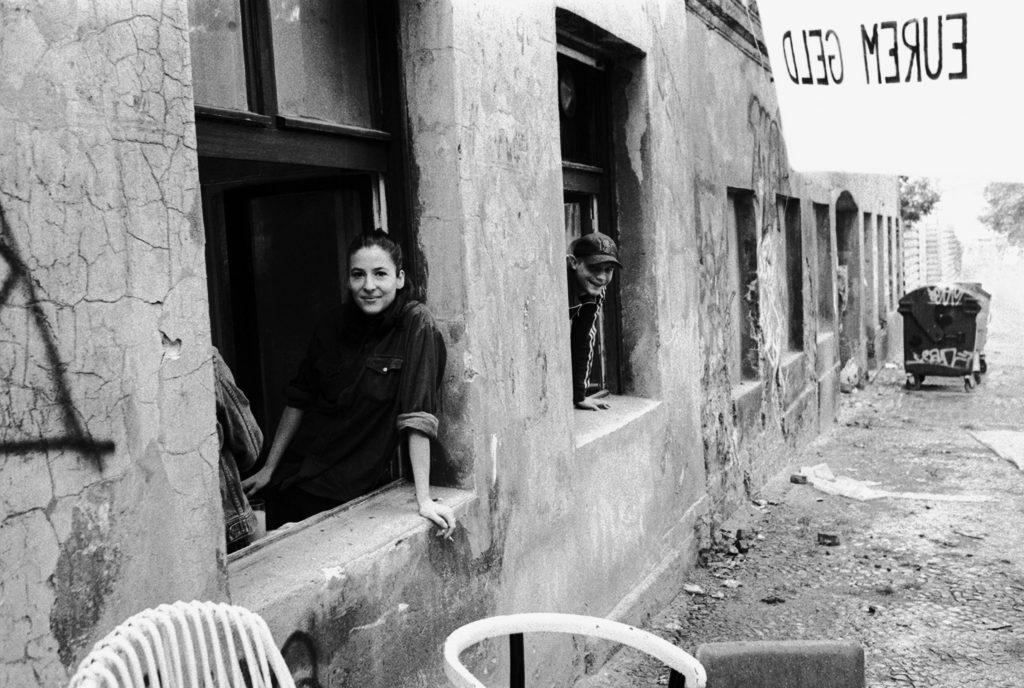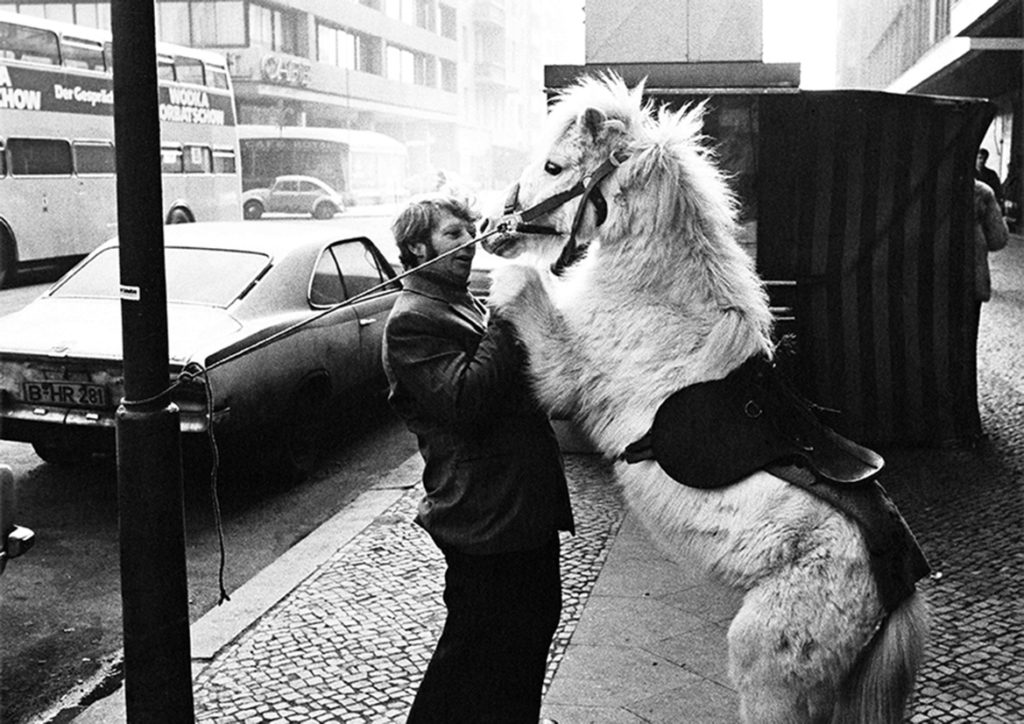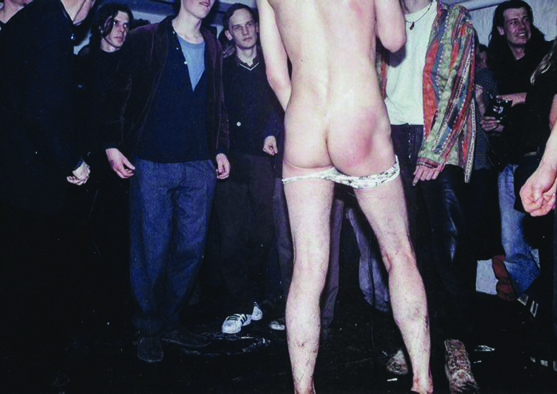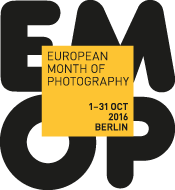
Eva Otaño Ugarte, Eurem Geld, 1995
Eröffnung: Fr. 30.09.2016 – 19 Uhr
Ausstellung: 01.10. – 22.10.2016 – Mi – Fr 13 – 19 Uhr / Sa. 13 – 17 Uhr
Finissage: So. 23.10.2016 – 17 Uhr
Drei Fotografen präsentieren drei Dekaden, drei Sichtweisen und drei Visionen von Berlins wildesten Seiten: Straßen, Chaos, Kunst, Popmusik, Subkultur. In Berlin ist alles permanent in Bewegung; ständig entstehen neue Konstellationen wie in keiner anderen Stadt der Welt. Künstler, Hausbesetzer und Hedonisten jeder Couleur streben nicht nach kommerziellem Erfolg und verweigern sich der Anpassung ans Establishment. Der Spirit dieser Stadt wird vom Hier und Jetzt bestimmt und trägt zur Entstehung von Wild Wild Berlin bei.
Miron Zownir (*1953) ist einer der radikalsten Fotografen unserer Zeit. Er fotografierte in westlichen Großstädten und in Osteuropa, fing in seinen Aufnahmen die Außenseiter der Gesellschaft ein und bot tiefe Einblicke in verschiedene subkulturelle Kreise. Eva Otaño Ugarte (*1964) fotografierte in den 1990er Jahren die Underground-Szene von Berlin Mitte und erforschte dabei die Schnittstelle von Dokumentation, Kunst und Konzept. Sebastian Mayer (*1973) konzentriert sich als Fotograf auf Porträts und Architektur, und obwohl die Fotografie sein bevorzugtes Medium ist, umfasst sein Werk auch Film, Malerei und Zeichnung.

Miron Zownir, Berlin 1979, 1979
„Was Miron Zownir in den 1980er in Bilder fasst, sind Randständige, Rebellische, die sich im Widerspruch zu der Saturiertheit einer Gesellschaft sehen, die sich in West wie Ost festgerannt hat und bleiernen Stillstand produziert. Dazu die Insellage des Westteils der Stadt – hier entsteht im (sub-) kulturellen Bereich ein Biotop geradezu paradiesischer Enthobenheit von ökonomische Zwängen und Verwertungsinteressen. Westberlin lebt ein surreales Leben als Schaukasten des Kapitalismus mit quasi-sozialistischer Alimentierung – und mit einer in Frankfurt, Köln und Düsseldorf mitleidig belächelten marktfernen künstlerischen Überproduktion. „Wildheit“ ist ein Statement gegen die Mutlosigkeit der postmodernen Gesellschaft und trägt autistische Züge.
Eva Otaño Ugarte dokumentiert in ihren Fotografien die Möglichkeitsräume (und deren Akteure), die mit dem Verschwinden eines überregulierten politischen und gesellschaftlichen Modells entstehen und in denen sich unvermittelt das Unreglementierte, das Freie und Wilde auf absehbare Zeit erproben können. Diese Räume entstehen in vielen Zentren im ehemaligen realsozialistischen Teil Europas, aber nur in Berlin sind das unmittelbare Aufeinandertreffen zweier Welten und die damit verbundenen sozialen und kulturellen Synergien möglich, nur in Berlin stehen in solcher Zahl Experten der Inbesitznahme und temporären Nutzung öffentlicher Räume bereit, um dort unverzüglich sub-kulturelle Konzepte umzusetzen und nirgends sonst ist die Verunsicherung der staatlichen Strukturen und Akteure so gründlich wie im Ostteil des sich neu bildenden Gesamtdeutschlands.
Die ersten Jahre der 1990er sind die Steigerung von „wild“. „Wild“ zu sein ist das Unvermeidliche, das Unausweichliche.
Der bisweilen heroische Gestus der Menschen in den Fotografien von Sebastian Mayer ist die Haltung im Angesicht der umfassenden Kommerzialisierung des Projekts „Underground“. Mit arm aber sexy ist Anfang der 2000er-Jahre der Markenkern des Labels „Berlin“ umschrieben. Meta-Events wie Pop-Komm oder Bread & Butter sollen Pop- und Sub-Kultur endlich auch in Berlin als Wirtschaftsfaktor etablieren. Die Deregulierung des europäischen Luftverkehrs tut ein Übriges und versorgt die boomende Club- und Partyszene der Stadt mit immer neuer Kundschaft. Die autochthone Berliner-Szene – oder was sich dafür hält – steht für Biodiversität und erhält Artenschutz.
Wildheit weicht permanenter Erregtheit und die ist ein Hündchen, das am Wochenende Gassi geführt werden will.
Und heute in den späten 2010er Jahren, wo uns das „Wilde“ auf allen Ebenen des Politischen und Gesellschaftlichen anfällt und in Atem hält, scheinen die in der Ausstellung WILD WILD BERLIN in den Blick genommen Jahre ein idyllischer Ort irgendwo vor der Zeit, in der uns unser ganz eigener postkolonialer Albtraum einholt.“ (Stephan Kruhl)
Three photographers present three decades, three views and three visions of Berlin at its wildest: streets, chaos, art, pop music, the subculture. Everything is forever in motion in Berlin, constantly shifting into ever-new constellations like in no other city in the world. Artists, squatters and hedonists of all stripes aren’t looking for commercial success and resist adapting to the established. The Here and Now informs this city’s spirit and contributes to the creation of Wild Wild Berlin.
Miron Zownir (born 1953) is one of the most radical photographers of our time. He photographed in major western cities and Eastern Europe, capturing society’s outsiders and providing piercing insights into various subcultural circles. Eva Otaño Ugarte (born 1964) investigates the interface between documentation, art and concept, photographing the underground scene of Berlin’s borough of Mitte in the 1990s. Sebastian Mayer (born 1973) is a photographer who focuses on portraiture and architecture, and while his artistic works use photography as the predominant medium, it also involves film, painting and drawing.

Sebastian Mayer, Berlin 2000, 2000
„What Miron Zownir captures in his pictures in the 1980s are marginal, rebellious types who see themselves at odds with a saturated society that has become stuck both in the East and the West, and which generates leaden inertia. Add the insular situation of Berlin’s Western half: it is in this (sub-)culture that a biosphere of near paradisiacal detachment from economic necessity and exploitation interests evolves. West Berlin lives a surreal existence as capitalism’s showroom window, with quasi socialist subsidization – and with an unmarketable artistic overproduction that’s met with condescending smiles in Frankfurt, Cologne, or Düsseldorf. “Wildness” is a statement against the diffidence of a post-modern society, one which bears traits of autism.
In her photographs Eva Otaño Ugarte documents the “possibility spaces” (and the acting personnel therein) which develop once an overregulated political and social model disappears, in which abruptly the unregulated, the free and the wild can try themselves out for the time being. Such spaces evolve in many hubs of the formerly socialist part of Europe, yet only in Berlin the immediate confrontation between two worlds with its pertaining social and cultural synergies is possible; only in Berlin such a multitude of experts in the appropriation and temporal use of public space are at the ready to immediately realize sub-cultural concepts, and nowhere else is the destabilization of official structures and representatives more pronounced than in the Eastern part of the newly emerging unified Germany. The early 1990s are marked by an escalation of “wild”. Being “wild” is inescapable, is unavoidable.
The, at times heroic, attitude of the people in Sebastian Mayer’s photographs is one facing a comprehensive commercialization of the “underground” project. In the early 2000s the slogan “Arm aber sexy” (Poor yet Sexy) describes Berlin’s brand essence. Meta events such as Pop-Komm or Bread & Butter are to establish at long last the economic potential of pop- and sub-cultures in Berlin as well. The deregulation of European air traffic does its share, as it provides the booming party and club circuit with a constant influx of new customers. Berlin’s autochthonous “scene” – or what regards itself as one – represents biodiversity and receives endangered-species status. Wildness gives way to permanent excitation, and that creature is a doggie in need of being walked on weekends.
Today now, in the late 2010s, when the “wild” assaults us at all levels political and social, and keeps us panting, the years reflected by the exhibition WILD WILD BERLIN seem to be an idyllic place fallen out of our time, when our very own post-colonial nightmare catches up with us.“ (Stephan Kruhl, translation Johannes Sabinski)

